The Shining part 4: A Month Later, Tuesday, Thursday, Saturday
A MONTH LATER
The Torrances have moved into the Overlook. A month has gone by without anyone getting murdered.
Things seem to be going okay, all things considered. Wendy, who seems to enjoy being a wife and mother, acts like she’s playing house in an enormous home. Like Halloran says, “It’s still ain’t nothing but a kitchen.” Yes, you make your breakfast in the kitchen, then you wheel it on a cart past the Gold Room, into the hotel lobby, through God knows where, into an elevator, down the hall, up the stairs and into your bedroom — just like at home!
Danny, meanwhile, seems fine — the hotel is a huge playground for him. We see the first of three tracking shots following him around on a circuit of the hotel on his tricycle. I don’t know how these shots play now, thirty years later, but when they were shown in theaters in 1980 the Steadicam was brand new and they blew people’s minds. The bliss, the sheer joy of the vigor of Danny’s pedaling and the sound of the wheels on the floor made audiences giggle and swoon. They were suddenly children again. That sense of childlike wonder is key for making the shot work, for reasons we’ll get to in a moment.
(It’s worth noting that Danny, on his tour, cycles past a pool table with red felt, which would receive a much bigger role in Eyes Wide Shut.)
Wendy takes breakfast up to Jack. Jack, it seems, is perfectly happy at the Overlook, except in his writing work. “Lots of ideas, no good ones” is how he describes his progress. Given his eventual trajectory, “lots of ideas, no good ones” can be seen as applying to more than just his writing. As happy as Jack seems to be at the Overlook, he’s obviously barely concealing his rage at Wendy. When she says that writing is simply a matter of settling into a routine, he says “Yep, that’s all it is,” with an inflection that adds “That, and chopping you up with an axe.”
So Jack is happy at the Overlook, except for his writing, which, we see, is at a standstill. Instead of spending time with Wendy and Danny, he spends his writing time playing catch with himself, or, rather, playing catch with the Overlook, since he’s throwing the ball against the “Indian” mural in the Colorado Lounge.
(“Are all these designs authentic?” Wendy asks Mr. Ullman when he shows them around. Ullman says something about how all the decor is based on Navajo and Hopi designs. There is no indication that he sees anything wrong with cramming the designs of two different nations together, or of reducing a people’s religious culture to hotel decor. Now Jack uses that same decor as a handball court.)
While Jack plays catch, Wendy and Danny navigate the hedge maze outside. So we see that Danny has someone, at least, on his side, someone who will play with him and keep him company during the now-four-months left on their tenure at the hotel. “To navigate the maze,” of course, is a key action in The Shining, which is a movie about a maze. If The Shining is a movie about navigating a maze, what is the metaphor? What is the uber-maze to be navigated? Well, there’s “the mind,” specifically Jack’s mind, which must be successfully navigated every day by Wendy and Danny in order to stay alive. Then there is the bigger maze of “the world,” or at least “America,” which we all need to navigate in order to keep from getting lost in this cockeyed caravan. Danny and Wendy, we see, have ventured out of the hotel to navigate the maze, while Jack, wandering both the maze of the Overlook and the maze of his own mind, is utterly stuck, utterly lost.
TUESDAY
Wendy, in the kitchen, makes a family dinner, with an enormous can of fruit cocktail. Again, she is tiny, the kitchen is huge, but she’s pretending that all this is normal, all this is manageable, and we get the impression that Wendy has spent a lot of her life in situations over her head, pretending everything is manageable. On the TV, we get a weather report of imminent snow. Dramatically, what the scene says is “A STORM APPROACHES.” Again, Kubrick has cloaked this rather gothic development in the most banal terms possible, as a local-news report.
Danny, meanwhile, continues on his rounds on his tricycle. And the viewer is pleased because the shot recalls the earlier, joyful circuit. This time, however, Danny stops in the hallway next to Room 237, which, we have been warned, is the most terrifying room in the hotel. Lots of bad stuff has happened at the Overlook, apparently, but nothing compares to the horrors that lie within Room 237. Dramatically, we see Danny enter the world — his playground now has a dark edge to it, there is a place, he is reminded, where he is not meant to go.
Later, Jack seems to be able to finally get some writing done. Good for Jack! We see him at his huge table in the Colorado Lounge, with a typewriter and a big scrapbook laid out beside him. Assuming that the scrapbook was found at the hotel, it makes sense that Jack is writing something about the Overlook. Further, it makes sense that what he’s studying is the story of Charles Grady, The Caretaker Who Murdered His Family.
What’s going on in the maze of Jack’s mind at this point? If he was itching to murder Wendy and Danny, he could have done so a month ago. So it seems that that thought hasn’t taken full form in his mind yet, or at least not to the point where he has moved toward action.
Wendy interrupts Jack at his work to tell him about the impending storm, which provokes one of the more disturbing domestic scenes in movie history. Wendy, in spite of being married to a writer for years, apparently is still under the impression that writing is something produced like chairs or cookies. Whether Jack Torrance has ever worked like this or not, he’s certainly not working like that now, and his violent outburst at Wendy is all the more frightening because it’s an outburst that every writer has in his or her mind at least once or twice in their career. (Jack Nicholson says he wrote the scene himself, based on an incident that happened early on in his career as a screenwriter.) “I just want to finish my work,” says Jack, Jack the artist, Jack the suffering poet, and we are reminded that the artist, at least the artist in movies, is often not a nice person. What’s more, Jack and Wendy clearly have a very bad relationship — while this outburst is extraordinary, it’s not so extraordinary that Wendy doesn’t go straight to Danny, scoop him up and high-tail it out of the hotel, which is what any sane person would do. Jack, it seems, has always been a bully and a monster, and Wendy, it seems, has always been subservient and cowardly.
THURSDAY
And, with one simple title card, the Torrance’s fate is sealed. The storm has struck and the Overlook is snowed in. Wendy and Danny, still making the best of their dyad friendship, play in the snow, while Jack stays in his man-cave, his workspace, and stares, at, at — something — what, it’s unclear.
SATURDAY
Jack, suddenly, is at work again. The writing seems to be going smoothly now — whatever he was looking at on Thursday, it seems to have inspired him. Of course, we’ll eventually find out that his work is inspired in the most twisted way imaginable. (Etymologists will also know that “inspire” is a word that means “to breathe into,” meaning that the god, or the muse, has “breathed into” the inspired artist. Something has certainly breathed into Jack, but it’s not a god or a muse.)
Wendy, meanwhile, is all alone, trying the phone, to no avail. We sense her loneliness and isolation, and her fear, as she calls the local forest-ranger guy on the radio. The forest-ranger guy hears her fear and isolation too, and suggests that she keep her radio on for the rest of the winter. Wendy could have snatched the moment after Jacks’ furious outburst on Tuesday, but she didn’t, and she’s stuck now. I wonder what their life is like now on the outskirts of the narrative — is Jack still coming to bed, is Wendy still cheerfully making him breakfast? Is that how entrenched this bad relationship is?
Meanwhile, Danny is back on his circuit with his tricycle. And, aha! Kubrick gets you. First time around, Danny On His Tricycle is a joy, second time, doubts are raised, third time, dead girls in the hallway. What is Danny to do with this vision of dead girls in the hallway? It’s quite an upsetting thing, and he does the same thing he has done since Jack dislocated his arm three years earlier — he turns to Tony, the little boy who lives in his mouth. Tony, the reader will recall, is Danny’s disassociated self. Danny’s not a schizophrenic, he’s a troubled child, and he’s placed his magical powers into another personality to help him deal with it. To him, he doesn’t have psychic powers, Tony does. And so he turns to Tony when he sees the dead girls, and Tony talks him down. “They’re not real,” Tony says, “They’re just like pictures in a book.” In this case, I’m guessing they’re like pictures in the book that Jack is studying for his work.
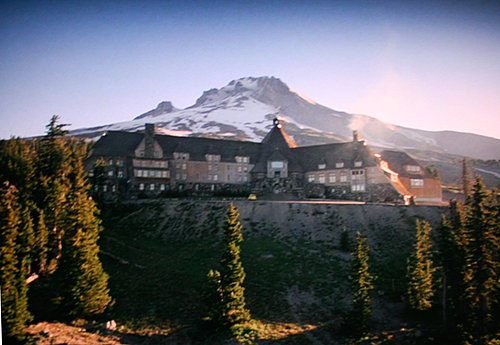
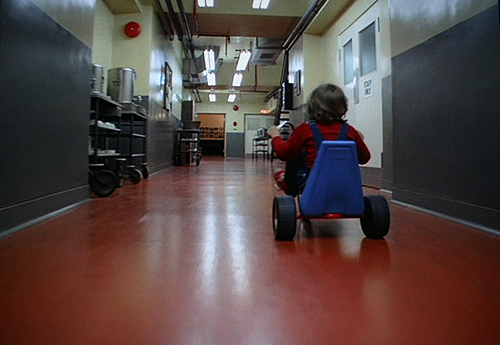
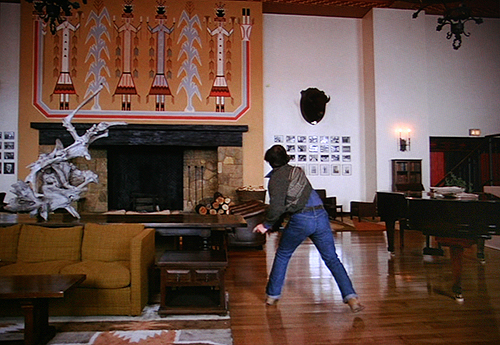
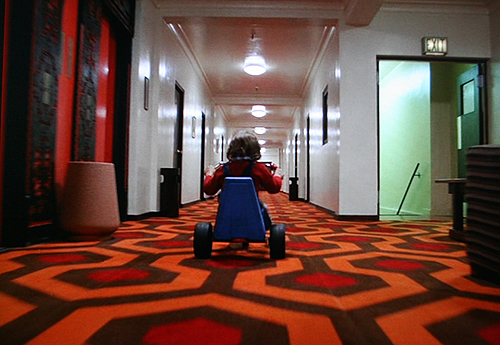
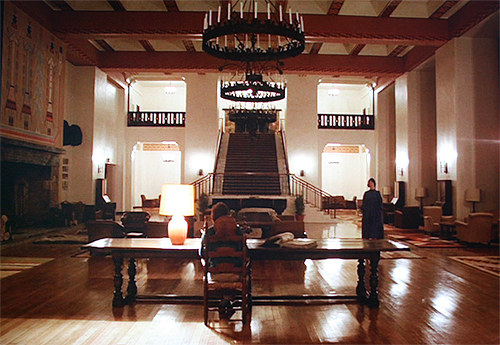
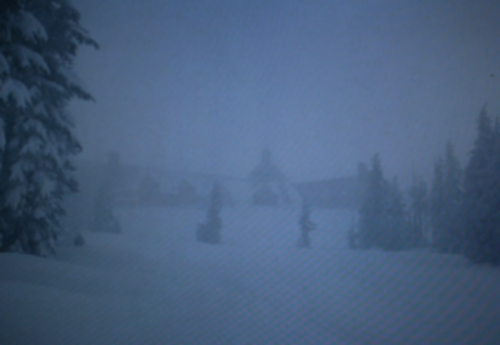
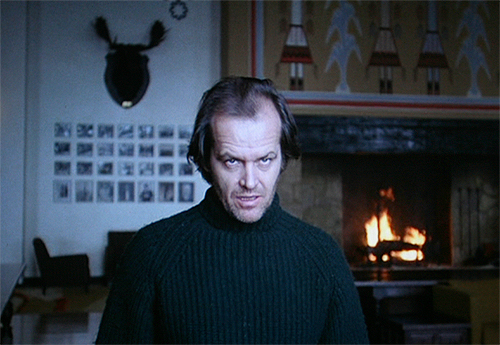
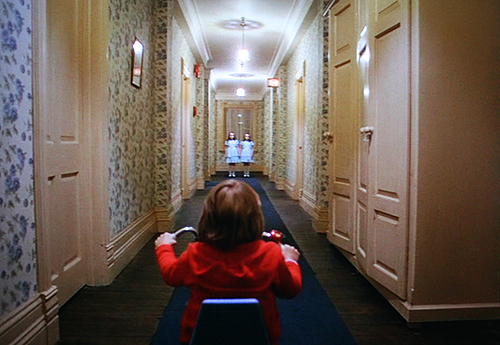
If I recall, the idea of Steadicam was actually invented specifically for these shots in this movie … it’d never been done before but Kubrick wanted it … that’s my memory.
It had already been invented, but Kubrick didn’t take any chances — he hired the camera’s inventor to do the shots in the movie.
Indeed, the first Steadicam shot was performed for a mind-boggling tracking shot through a Hooverville in Bound for Glory in 1976.
Ah, so that’s it … I think, though, that Kubrick put the operator and camera on a wheelchair or something to that effect to follow the bike, that’s my memory (but I’m too lazy to look for the book right now) …
As Mark G remarks below, Kubrick was the first one to turn the rig upside-down, to get it that close to the floor.
Josh is also correct. In addition to being underslung, many of the interior shots were achieved by attaching the Steadicam arm to a mount on a wheelchair.
I’m not sure if this was the first time the arm was mounted separate from the operator, but that’s pretty standard practice nowadays for any shots moving quicker than a brisk jog.
As can be seen here:
http://www.youtube.com/watch?v=182eGQPLrYc&feature=player_detailpage#t=379s
I thought they invented steadicam for Rocky, and subsequently won a technical Oscar for it. Maybe they just refined it.
Indeed, the Steadicam had been around for several years by this time, but this was the first time it had been used ‘underslung’ – that is at the base of the pole, rather than the top.
Garret Brown remarked upon meeting Kubrick that one of the first questions he asked, was whether this was possible.
There he was – having invented perhaps the most remarkable and revolutionary camera mount since the tripod – and Kubrick saw a new way of using it.